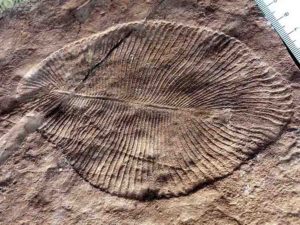
Some of the earliest animals on Earth were soft-bodied ocean-dwellers that ranged from a few inches to several feet and were shaped like circular discs, tubes, or cushion-like bags.
While fossil impressions from the Ediacaran Era — 635 to 541 million years ago — reveal their existence, little is known about this fascinating group of animal-like creatures, which preceded more complex animals with skeletons.
In a paper published Friday, May 4, in Nature Communications, researchers at the University of California, Riverside, used biomarkers in ancient rocks to learn more about the environmental conditions and food sources that sustained this group of animals, called the Ediacara Biota. Led by Gordon Love, a professor of biogeochemistry at UCR, the team studied molecular fossils, known as lipid biomarkers, made by the ancient biological communities and preserved within sedimentary rocks that contain early animal fossils. The communities they studied lived off the coast of the ancient continent Baltica — encompassing modern day Russia, Ukraine and the Baltic States — between 560 to 540 million years ago.
Love said the Ediacara Biota lived in nutrient-poor regions of the sea on the continental shelf, an extension of land under the ocean that results in relatively shallow water. Despite this oligotrophic environment, the researchers found there were sufficient nutrients and organic debris for feeding sustained by bacterial primary production and dissolved organic matter.
The team also observed a dearth of sponge biomarkers, suggesting possible niche competition between the Ediacara Biota and sponges in different marine settings.
“Different environmental conditions and nutritional resources could have selected for very different community structures in different regions of the Ediacaran oceans,” Love said.
Reference:
Kelden Pehr, Gordon D. Love, Anton Kuznetsov, Victor Podkovyrov, Christopher K. Junium, Leonid Shumlyanskyy, Tetyana Sokur, Andrey Bekker. Ediacara biota flourished in oligotrophic and bacterially dominated marine environments across Baltica. Nature Communications, 2018; 9 (1) DOI: 10.1038/s41467-018-04195-8
Note: The above post is reprinted from materials provided by University of California – Riverside.










